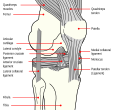Quadriceps: Difference between revisions
m Bot: link syntax/spacing |
No edit summary |
||
| Line 24: | Line 24: | ||
The proper Latin [[plural]] form of the [[adjective]] ''quadriceps'' would be ''quadricipites''. In modern English usage, ''quadriceps'' is used in both [[Grammatical number|singular]] and plural. The singular form ''quadricep'', produced by [[hypercorrection]], is frequently used. |
The proper Latin [[plural]] form of the [[adjective]] ''quadriceps'' would be ''quadricipites''. In modern English usage, ''quadriceps'' is used in both [[Grammatical number|singular]] and plural. The singular form ''quadricep'', produced by [[hypercorrection]], is frequently used. |
||
==Portio[[ilium (bone)|ilium]]. It is named from its straight course. |
|||
==Portions== |
|||
It is subdivided into four separate portions or 'heads', which have received distinctive names: |
|||
*[[Rectus femoris]] occupies the middle of the thigh, covering most of the other three quadriceps muscles. It originates on the [[ilium (bone)|ilium]]. It is named from its straight course. |
|||
*The other three lie deep to rectus femoris and originate from the body of the [[femur]], which they cover from the [[Human trochanter|trochanter]]s to the [[Condyle (anatomy)|condyle]]s: |
*The other three lie deep to rectus femoris and originate from the body of the [[femur]], which they cover from the [[Human trochanter|trochanter]]s to the [[Condyle (anatomy)|condyle]]s: |
||
Revision as of 15:59, 13 January 2012
| Quadriceps | |
|---|---|
 Muscles of lower extremity. (Rectus femoris removed to reveal the vastus intermedius.) | |
| Details | |
| Origin | combined rectus femoris and vastus muscles |
| Insertion | tibial tuberosity |
| Artery | femoral artery |
| Nerve | Femoral nerve |
| Actions | Knee extension; Hip flexion (R.Fem. only) |
| Identifiers | |
| Latin | musculus quadriceps femoris |
| MeSH | D052097 |
| TA98 | A04.7.02.017 |
| TA2 | 2613 |
| FMA | 22428 |
| Anatomical terms of muscle | |
The quadriceps femoris (Latin for "four-headed muscle of the femur"), also called simply the quadriceps, quadriceps extensor, quads, is a large muscle group that includes the four prevailing muscles on the front of the thigh. It is the great extensor muscle of the knee, forming a large fleshy mass which covers the front and sides of the femur.
The proper Latin plural form of the adjective quadriceps would be quadricipites. In modern English usage, quadriceps is used in both singular and plural. The singular form quadricep, produced by hypercorrection, is frequently used.
==Portioilium. It is named from its straight course.
- The other three lie deep to rectus femoris and originate from the body of the femur, which they cover from the trochanters to the condyles:
- Vastus lateralis is on the lateral side of the femur (i.e. on the outer side of the thigh).
- Vastus medialis is on the medial side of the femur (i.e. on the inner part thigh).
- Vastus intermedius lies between vastus lateralis and vastus medialis on the front of the femur (i.e. on the top or front of the thigh), but deep to the rectus femoris. Typically, it cannot be seen without dissection of the rectus femoris.
All four parts of the quadriceps muscle ultimately insert into the tibial tuberosity of the tibia. This is via the patella, where the quadriceps tendon becomes the patellar ligament, which then attaches to the tibia.
Actions
All four quadriceps are powerful extensors of the knee joint. They are crucial in walking, running, jumping and squatting. Because rectus femoris attaches to the ilium, it is also a flexor of the hip. This action is also crucial to walking or running as it swings the leg forward into the ensuing step. The quadriceps, specifically the vastus medialis, plays the important role of stabilizing the patella and the knee joint during gait.[1]
Training
In strength training, the quadriceps is trained by several leg exercises. Effective exercises include the squat and leg press. The isolation movement (i.e. targets solely the quadriceps) is the leg extension exercise.
Additional images
-
Knee diagram
-
Capsule of right knee-joint (distended). Lateral aspect.
-
Cross-section through the middle of the thigh.
-
Anterior aspect of right leg.
-
Front and medial aspect of right thigh.
-
Lateral aspect of right leg.
-
The leg extension is an isolation exercise.
References
- ^ Therapeutic Exercises, Carolyn Kisner & Lynn A. Colby, 5th ed. (2002) 692-93.






